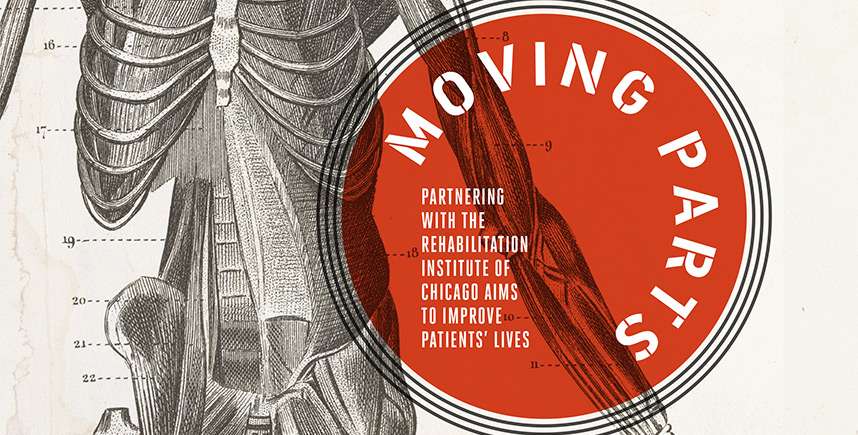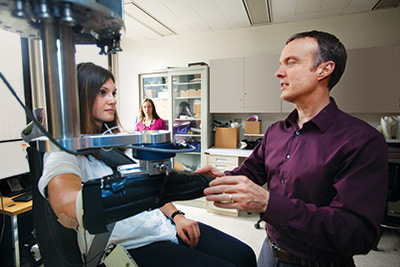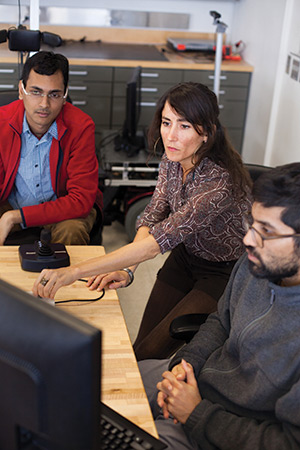Moving Parts
Partnering with the Rehabilitation Institute of Chicago aims to improve patients' lives

Every year, thousands of people from around the globe visit the Rehabilitation Institute of Chicago (RIC) in search of better outcomes. Many have debilitating diseases, spinal cord or brain injuries, limb amputations, or are recovering from stroke. Through research and innovative thinking, Northwestern Engineering faculty contribute directly and indirectly to helping these patients adapt, continually improve, and eventually recuperate.
Startling Findings
Shaking someone's hand, waving hello, and dribbling a basketball might seem like similar activities. All require up-and-down motions in the arm, wrist, and hand, but that's where the similarities end. Each of these activities depends on very different mechanical properties within our arms, which can be modified by varying the signals to and from the nervous system.
"We change the mechanics of our limbs for different tasks," says Eric Perreault. "We do it often, but we don't usually think about it."
Perreault, however, does think about it—a lot.
 With a joint appointment in the Department of Biomedical Engineering and at RIC, Perreault seeks to understand how humans use their limbs to interact with the physical world. He is particularly interested in how stroke, spinal cord injuries, and other motor deficits affect the musculoskeletal and nervous systems. As a researcher, his ultimate goal is to help others develop interventions that improve these individuals' lives.
With a joint appointment in the Department of Biomedical Engineering and at RIC, Perreault seeks to understand how humans use their limbs to interact with the physical world. He is particularly interested in how stroke, spinal cord injuries, and other motor deficits affect the musculoskeletal and nervous systems. As a researcher, his ultimate goal is to help others develop interventions that improve these individuals' lives.
"The interactions between the nervous system and the mechanical system are still poorly understood," says Perreault, professor and chair of biomedical engineering. "There are a lot of things we can't measure in humans because those critical interactions happen below the surface of our skin."
One of Perreault's newest studies looks deep below the skin to the brain's most hidden part: the brainstem. Researchers know little about this region because it's difficult to access and too buried to record easily. Forming a connection between the brain and the spinal cord, the brainstem coordinates many important involuntary reflexes, including the startle response experienced when hearing an unexpectedly loud sound.
"While many reflexes, including a startle, are stereotyped, there are many automatic responses at the interface of involuntary and voluntary control," Perreault says. "These subconscious responses are fast enough to be considered reflexive, but share many of the task-specific complexities normally attributed to volitional movements."
The brainstem allows, among other things, for the rapid response to external stimuli. Perreault's work with stroke subjects provides strong evidence that some of these rapid reactions can be elicited without input from higher brain centers. In fact, his team has demonstrated that by activating the brainstem through loud noises to invoke a startle response, it is possible to get brain injury survivors to move as quickly as unimpaired subjects.Perreault has spent years exploring how these automatic responses contribute to our ability to regulate limb mechanics and movements. Those studies have recently led him to the brainstem. His team has found that the brainstem contributes to movements throughout the arm and hand, contrary to earlier beliefs.
Perreault's team is using these findings to expand our understanding of brainstem function and of how that function influences our ability to interact with the physical world. He imagines that this understanding may eventually lead to novel interventions for stroke rehabilitation.
On a Roll

Ironically, the people who most need wheelchairs or prosthetics are sometimes the least able to operate them.
“We have this paradox,” says Brenna Argall. “The more motor-impaired a person is, the more limited they are by the control signals they can provide. Yet, they may need even more complex help because they face a wider mobility gap. That’s where robotics autonomy comes in.”
With a joint appointment with RIC and the Department of Electrical Engineering and Computer Science, Argall is developing an autonomous wheelchair and a robotic arm for patients with motor impairments.
Similar to the technology used in a driverless car, Argall’s wheelchair uses sensors and artificial intelligence to share control with a human. The infrared and ultrasonic sensors allow the wheelchair to sense obstacles in its path to avoid collisions and navigate difficult spaces, such as narrow doorways. The wheelchair is currently being tested with RIC patients.
“Smart wheelchair research has been around for 25 years,” says Argall, an expert roboticist. “But there haven’t been any transitions to the commercial market, often because the robotics was not robust enough. Within the past five to ten years, robotics autonomy has reached the point where we have technology that is robust enough to operate out in the world.”
Using machine learning, Argall’s wheelchair learns from its interactions with a human being over time. If the patient’s impairments worsen because of a degenerative disease or improve with physical therapy, the wheelchair naturally adapts to those changing abilities.
"We don’t want to present a static machine,” Argall says. “We want it to adapt seamlessly over time without needing to bring it back to the lab for adjustments to new circumstances.”
Argall’s robotic arm uses similar sensors as the wheelchair, but instead of avoiding objects, the arm locates objects to grab. Argall’s group performed an exploratory study with the arm at RIC in summer 2015.
The goal for both projects is to make machines that are not too complex for patients to handle. Instead, the users should feel comfortable and in control.
“It’s not that we’re trying to take humans out of the loop,” she says. “We’re trying to use robotics autonomy to bridge the control gap and make machines that are accessible and easy to operate.”
RIC Partnerships Across Northwestern Engineering
Hand Model
Wendy Murray, associate professor of biomedical engineering and physical medicine and rehabilitation, focuses on hand function. She has created a model to understand and improve what happens during hand surgery and seeks to quantify the mechanics of the muscles in the hand.
Brain Games
Matthew Tresch, associate professor of biomedical engineering and physical medicine and rehabilitation, studies how the brain controls joints. His particular interest lies in how the brain actively regulates the stresses and strains within the knee to minimize injury.
Stimulating Work
In collaboration with Perreault and Tresch, Kevin Lynch, chair and professor of mechanical engineering, recently finished a study that used electrical stimulation to reanimate paralyzed arms. Already showing promise in human subjects, the system could allow paralysis patients to perform daily tasks such as eating, combing their hair, and turning a doorknob.
